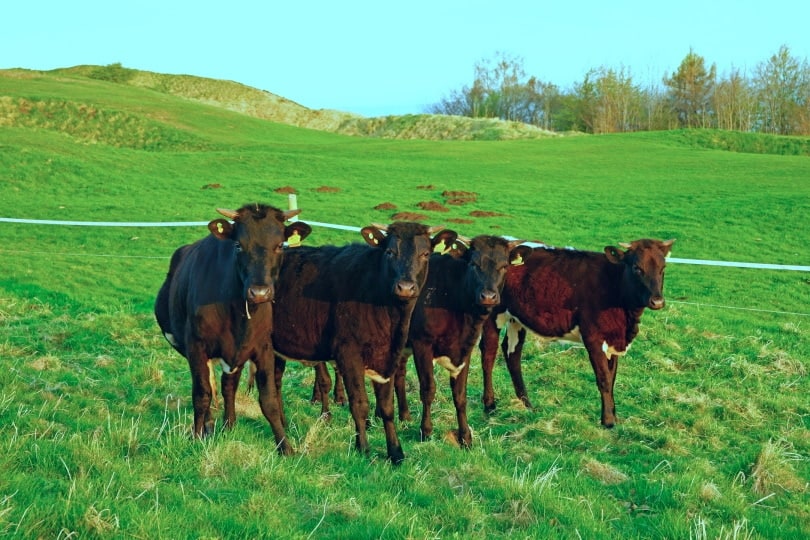The Gloucester Cattle breed is a dual-purpose cattle named after their place of origin, Gloucestershire, England. This breed of cattle almost became extinct from intensive farming, with one herd remaining in 1972. The Gloucester Cattle Society was formed in 1919 and revived in 1973 to step in and save the breed.1 Today, there are approximately 700 registered females.
The Gloucester Cattle breed is recognized as a rare breed considered “at-risk” by the Rare Breeds Survival Trust, which is on a mission to save them.2 In this article, we’ll explore the facts, uses, origins, and characteristics of this ancient breed.

Quick Facts about the Gloucester Cattle Breed
| Breed Name: | Gloucester |
| Place of Origin: | Gloucestershire, England |
| Uses: | Milk and beef production, draught purposes |
| Bull (Male) Size: | 1,650 pounds |
| Cow (Female) Size: | 1,100 pounds |
| Color: | Black/brown with a white streak on back, belly, and tail |
| Lifespan: | 15 to 20 years |
| Climate Tolerance: | Native climates |
| Care Level: | Docile, amenable, do well with individual care, easy to manage |
| Production: | Beef and milk |
| Horned: | Yes |
Gloucester Cattle Breed Origins
The Gloucester cattle is one of the oldest breeds that originated in the 13th century in the Severn Valley of England and were once common in the Western Country of England. They are still at risk of extinction, but efforts are underway to save this old breed.
In the 18th century, the Gloucester population declined because of disease and was replaced by Longhorns. A sudden interest in 1896 helped form the Gloucester Cattle Society in 1919. Despite the new interest, foot and mouth disease broke out in Gloucestershire in 1927, which threatened the population once more. By 1972, only one herd remained.

Gloucester Cattle Breed Characteristics
Gloucester cows are slow to mature. As a result, they produce a flavorful marbled beef suited for slow cooking. The meat reaches its peak when the cow is over two years of age. They are hardy cattle that are well adapted to the native climates of England and are easy to care for. They do well with individual care and are quite docile. The females are excellent, long-lasting mothers; some females calve well into their late teens without any complications. The male Gloucester weighs up to 1,650 pounds, and the females weigh up to 1,100 pounds.
Farmers who have taken on the task of conserving this rare breed seem to admire this cattle. They are calm in nature and pleasant to be around, making them ideal house cattle. They also do well with hand-milking and are grass-fed. In the early days, the bulls were exceptional for draught purposes due to their massive and strong builds.
Uses
Gloucester cattle is known for its dual purpose of beef and milk/cheese production. As for cheese, Jonathon Crump, the owner of Standish Park Farm near Stroud, uses the rare Gloucester to make unpasteurized semi-hard Single and Double Gloucester cheeses. He owns roughly 80 cows, and he uses 20 of them to make this rare cheese. Gloucester cheeses are a staple in Gloucestershire. Gloucesters make rich milk, and making Gloucester cheese would be impossible without them. The bulls were used for draught purposes as working oxen, but this gave way to machinery replacing them over time.
Sir Edward Jenner used this breed to produce a smallpox vaccine for the cowpox virus in 1786.
Appearance & Varieties
Gloucester cattle are black/brown in color with white tails, white bellies, and a distinctive white streak along their backs. They have upward horns with black tips, and their coat is fine and short. They have dark muzzles and dark skin around the nose and eyes and are known as a medium to large-sized breed. One may even say that these cows are gorgeous because of their beautiful dark brown or black color.
Population, Distribution & Habitat
Conservation efforts are underway by The Gloucester Cattle Breed in the UK, with approximately 1500 registered animals. Due to almost becoming extinct in 1972, the population of Gloucester cattle is small. For the people of the U.K. and Gloucestershire (their place of origin), the importance of conserving this rare breed is high due to their striking beauty and multi-purposes. Glouchester cheese is only made from Gloucester cattle because of their rich milk; no other cattle can produce milk suitable for this cheese.

Are Gloucester Cattle Good for Small-Scale Farming?
Small-scale farming usually doesn’t involve large animals. Chickens and pigs are mostly used for small-scale farming because this type of farming is focused on small crops. However, Charles Martell, a cheesemaker and farmer in Dymock, Gloucestershire, has kept a herd of over 20 Gloucester cows on his small farm since 1972, producing the cheeses that these cattle are known for.
These docile, beautiful, and gentle cows are still on the verge of extinction, but this rare cattle breed can thrive once more with more awareness. They have a rich history and served great purposes back in their heyday, and the few remaining show just how valuable they are. With 700 registered female cows, hopefully, these cattle will heavily populate farms all across the U.K. in the future, producing fantastic beef and cheeses for many years to come.
If you’d like more information about the Gloucester Cattle Breed or would like to help with conservation efforts, visit the Gloucester Cattle Society for more information.
Featured Image Credit: PJ photography, Shutterstock
